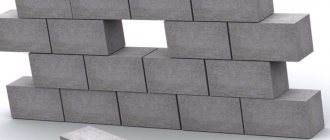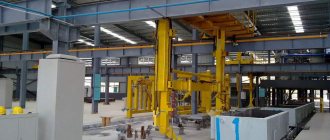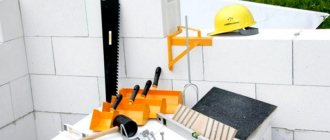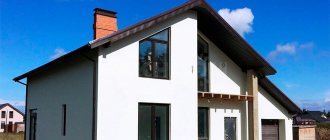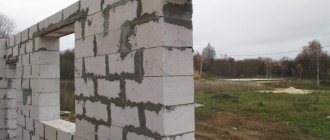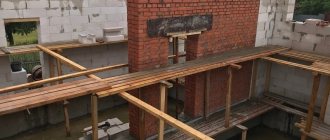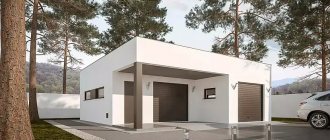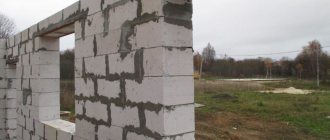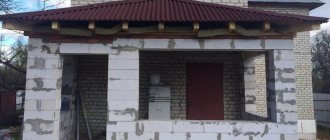Aerated concrete blocks are concrete that has many cells inside its structure.
Thanks to its fine porosity, the material has many positive qualities.
Aerated concrete is becoming increasingly popular because, thanks to its precise shape and light weight, it is convenient to work with and easy to calculate the required amount of material.
Let's look at how an autoclave unit differs.
Compound
Aerated concrete gets its amazing properties thanks to: limestone, Portland cement, calcium silicate, aluminum pastes (suspensions), calcium chlorides, water, etc., which are included in its composition in a strictly defined percentage ratio with each other (to form products with specified density characteristics etc.). The components are calculated in kilograms to obtain 1 m3 of the finished mixture. The binder can be lime, cement, slag, gypsum, either alone or in various mixtures. The most common base is cement with parts of lime. Additional additives make it possible to produce blocks of different colors and give the product specific properties.
Return to contents
Advantages of the material
Autoclaved aerated concrete has a number of technological, operational and production advantages. The blocks are light in weight, which is convenient when building walls. One unit of the product can replace up to 20 masonry bricks, which speeds up construction. Factory products have high manufacturing precision, which reduces the consumption of solutions and ensures the formation of smooth surfaces.
The low thermal conductivity of aerated concrete ensures heat retention in buildings without additional thermal insulation. Provides sound insulation and has the required degree of gas permeability (similar to wood). When heated, the material does not emit gases hazardous to health and has high fire resistance. It is also a neutral environment for microorganisms. The blocks are easy to drill and saw even with a hand saw.
Material processing is carried out with any tool. Products with a structural and thermal insulation density of the substance (from 500 kg/m3) are intended for the construction of walls of buildings of 3 floors and above. The durability of the products is tens of years. Construction costs are lower than other materials.
Return to contents
Technical characteristics and parameters
AGB can only be manufactured at specialized factories, because the equipment for its production is expensive, large in size and requires large areas to accommodate it. It is impossible to produce certified material in accordance with GOST using a homemade method.
Autoclave gas blocks have technical characteristics and parameters unique to them:
Under factory production conditions, autoclaved aerated concrete hardens evenly over the entire surface and, in parallel with this, the gas formation procedure occurs.
At the same time, special vibrating devices “expel” large air bubbles from the material, leaving only small pores of the same size as possible.Aerated concrete is obtained in a large area; it is cut into blocks of the required size, having a uniform fine-cell structure.
- This is a very durable material. Strength is denoted by the Latin letter D, and the number means density in kilograms per cubic meter. The most popular brands are considered to be autoclaved aerated concrete D500 and D600, and its compressive strength is B2.5 and B3.5.
- Autoclaved concrete hardens and becomes strong at the time of manufacture and after being placed in an autoclave, so it does not deform and has a shrinkage of no more than 0.4 mm/m.
- AGB walls “breathe”, creating a pleasant microclimate in the house. This material does not rot and is not affected by mold.
- The material is frost-resistant. Due to the high density and strength, walls made of such concrete will be warm with a thickness of only 40 cm, even if the grade of aerated concrete is D400-D500
Flaws
High-tech material (blocks) has the ability to absorb moisture from the environment and direct precipitation, so it requires additional waterproofing. After installation, the construction of walls made of aerated blocks already has lower thermal insulation due to cold bridges, which are created by fastening solutions, reinforced belts, metal mortgages, masonry joints, lintels, etc. Blocks produced outside the factory do not have standard characteristics for this material.
Return to contents
Features of masonry of autoclaved aerated concrete
High accuracy of dimensions and configuration determines some features of construction from this material.
- Foundation under the masonry it is very necessary thoroughly waterproof. Aerated concrete easily absorbs water and, if there is insufficient insulation, will draw moisture from the basement floor.
- The first row is laid on cement mortar.
- Aerated concrete blocks are large in size. Evenness and correctness of masonry check very carefully: necessarily in the corners and optionally in the row. After laying, the entire row is adjusted.
- Place blocks on glue. This allows you to reduce the thickness of the seam to a minimum - up to 0.5–3 mm. Such a wall does not allow the cold to pass through.
- Reinforcement is made in every 4 rows . For the rods, grooves are made in the stone.
- Before the ceiling or roof, a reinforced belt .
Areas of use
Autoclaved aerated concrete is widely used in the construction of industrial buildings, residential and commercial real estate. External walls are erected from autoclaved aerated blocks, which can be single-layer, combined or double-layer. Such internal walls are designed to take on the load of the upper floors.
It is important to lay the first row perfectly straight.
Autoclave blocks can form partitions and walls of fireproof rooms, as well as fill steel or concrete frames. A separate area of use is the formation of floor slabs (density of autoclaved aerated concrete 800-1000 kg/m3) in buildings. Material with a lower density (slabs) is used for thermal insulation of basements, attics, etc.
Autoclaved aerated concrete has been used in the production of wall panels for residential, public and industrial buildings. This applies to strip-cut reinforced panels. For typical projects of large-panel buildings, such panels consist of several standard sections.
Return to contents
What are the block sizes?
Types of aerated concrete blocks.
The low weight of porous concrete makes it possible to use building elements with increased dimensions. Building blocks made of aerated concrete have a length of 625 mm, a height of 200 and 250 mm, and a width of 100-400 mm. Such dimensions make it possible to significantly speed up and simplify the laying of walls, while the weight of the block remains within reasonable limits for its manual movement and laying.
An important advantage of autoclaved concrete is the accuracy and stability of the geometry of building elements (blocks). Autoclave curing of the concrete mass in the mold allows for clearly defined edges and corners, even smooth surfaces of the edges, very high dimensional stability, which remain almost unchanged over a long production time. If you take blocks from different production batches, then deviation is only possible within 1.5 mm in all directions (first category of accuracy) or up to 3 mm for the third category. Very strict standards have also been established for the stability of ribs and corners.
Production
High-quality autoclaved aerated concrete is produced in industrial conditions. All processes at production sites are automated, which makes it possible to form aerated concrete products of different formulations with the required characteristics. Production can be easily adjusted to produce products according to customer requests.
Return to contents
Preparing the Components
For the production of autoclaved aerated concrete, it is not quartz sand itself that is used, but a product of its processing, obtained by wet grinding in ball mills. Next, the sand slurry is further processed to the desired consistency in slurry basins. The compacted material is pumped into units that form the required weight proportions of the components.
Return to contents
Dosing and mixing
For this purpose, special automated modules are used, with a capacity of up to 40 cubic meters of products per shift. A fairly wide range of proportions of mixed starting materials allows the formation of autoclaved aerated concrete with specified characteristics. Dosed components of future products according to a given program are mixed with water, aluminum suspension and lime (Portland cement, etc.) in a mixer.
The molds with the mixture are transported to a chamber for maturation and pre-hardening.
The addition of gypsum slows down the thickening process of the mass. After the mixture reaches the density of pouring sour cream, it is poured into molds up to half the level. Regulating the amount and ratio of aluminum and lime determines the volume of hydrogen gas released and, as a result, the different densities of aerated concrete. Impact loads on the molds accelerate the chemical processes of replacing hydrogen in the voids with air in aerated concrete, increasing the volume of the material and filling the molds with it. Primary ripening and hardening of the material occurs.
Return to contents
Cutting into blocks
Approximately 1-2 hours after pouring, the mass begins to hold its shape and acquires strength sufficient for cutting. The structure of the material is already up to 85% of the volume made up of clogged air voids. Cutting is carried out using wire saws of automated equipment. On rotary tables, the solid mass, freed from formwork, is installed vertically and cut in vertical and horizontal planes. The operation forms the ends of products and, if necessary, end hooks, pockets for manual carrying, grooves, and ridges. The upper and lower layers of the array are sent for recycling to produce aerated blocks.
Return to contents
Autoclave processing
Autoclave treatment - concrete acquires additional rigidity and is dried.
Autoclaved aerated concrete is formed at elevated temperature and pressure, while non-autoclaved aerated concrete hardens at normal atmospheric pressure or under heating conditions. The cut mass is loaded into a special oven - an autoclave - for 12 hours. A temperature of 180 degrees and a pressure of 14 bar accelerates the formation of the structure of the artificial stone and the final hardening of the products. Autoclave technology is characterized by the formation of anisotropic properties of finished products.
Return to contents
Sorting and packaging
In an automated section, the blocks are separated from each other along previously made seams and selected according to quality. A special device moves finished products in batches onto pallets. The packaging process consists of waterproofing the pallets with shrink film and fastening tape.
Return to contents
